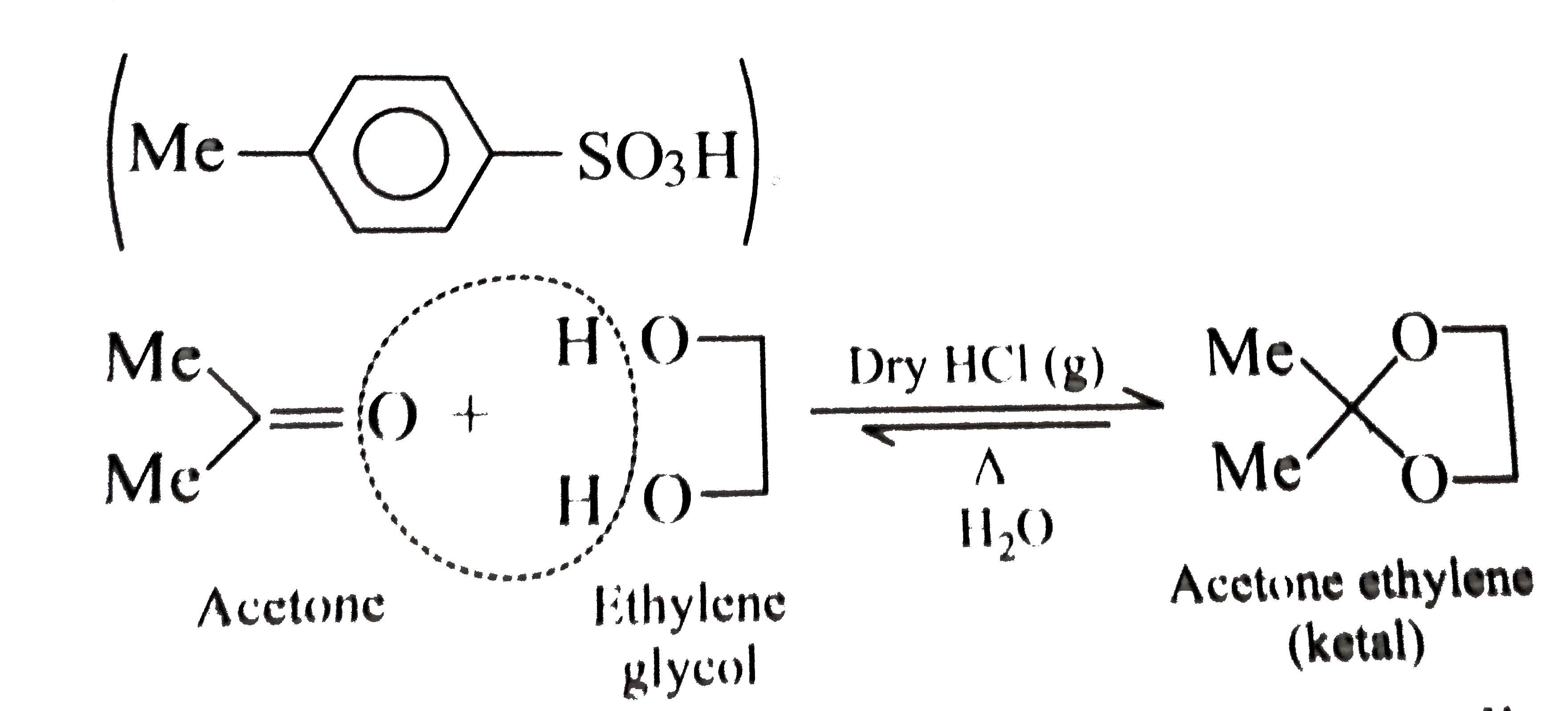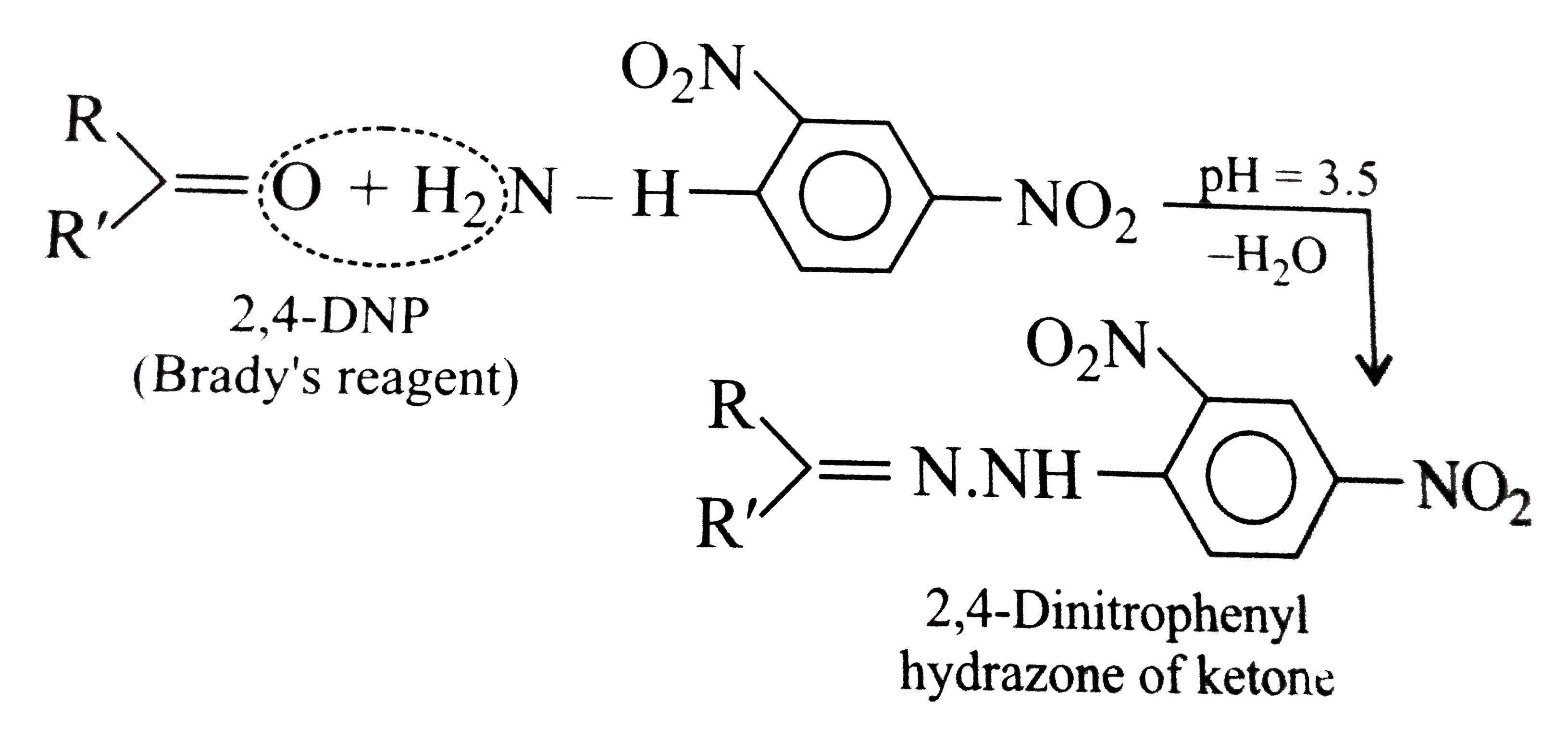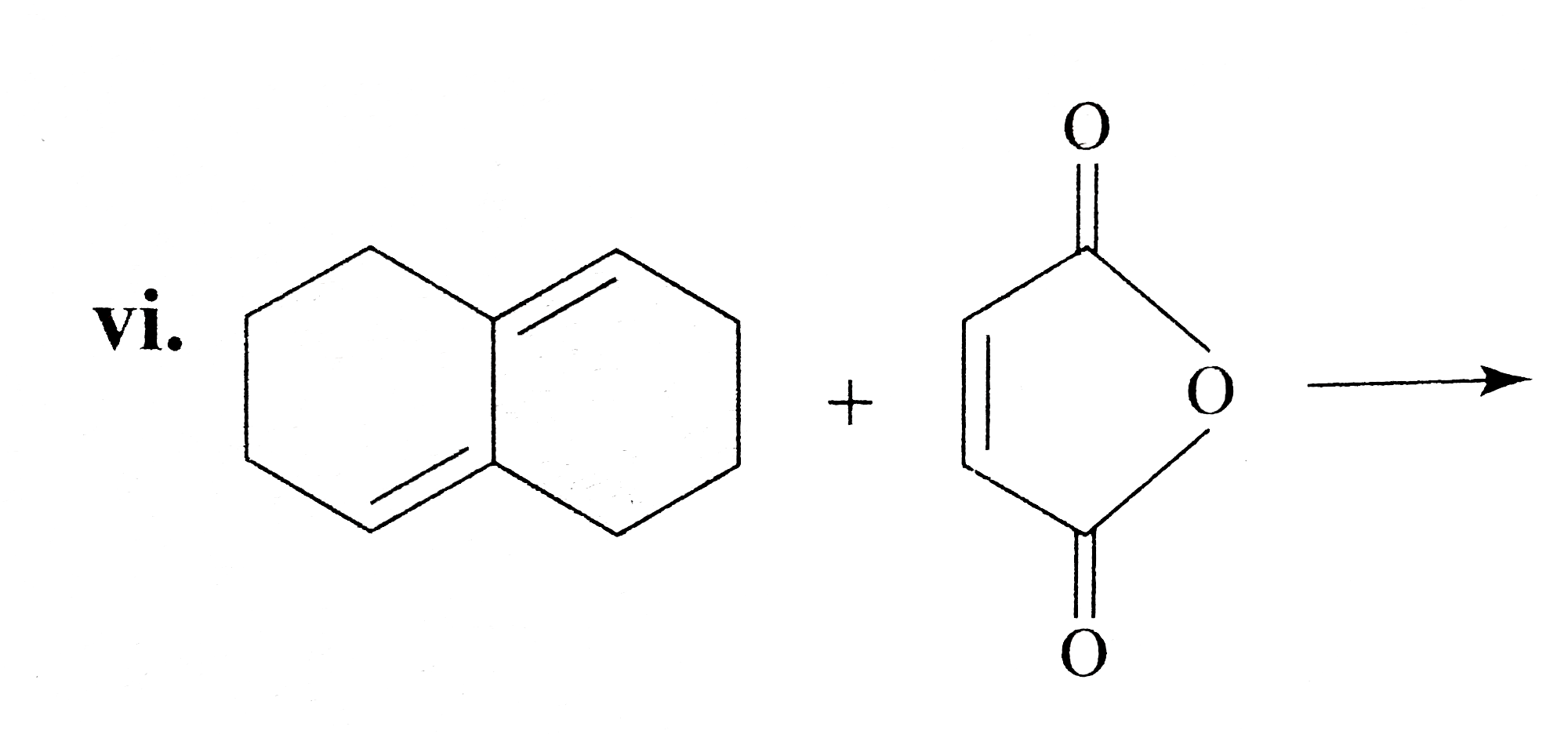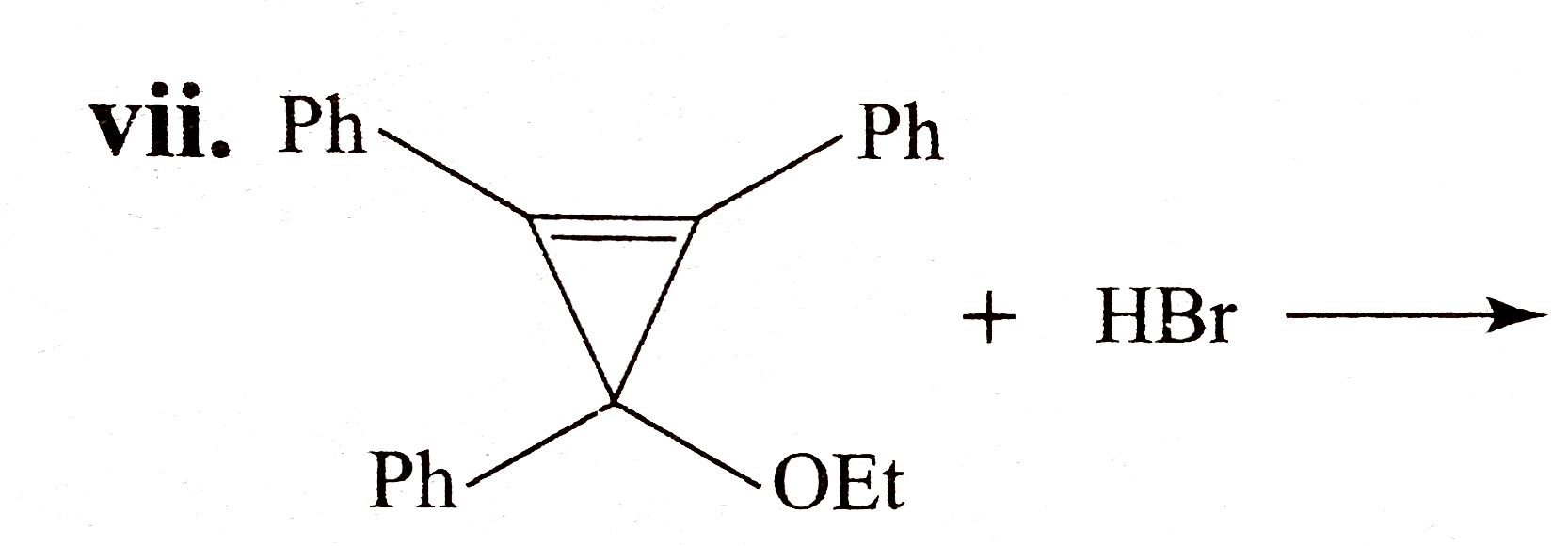What is meant by the following terms ? Give an example of the reaction in the case.
i. Cyanohydrin ii. Actal
iii. Semicarbazone iv. Aldol
v. Hemiacetal vi. Oxime
vii. Ketal viii. Imine
ix. 2,4-DNP derivative x. Schiff's base
i. Cyanohydrin: Compounds containing (OH) group and (CN) group on the same C atom are called cyanohydrin or gem-hydroxy nitriles. They are obtained by the addition of HCN to carbonyl compounds in weakly basic medium.

They are used to prepare α-hydroxy acid, e.g., lactic acid.
ii. Acetal: Compounds containing two alkoxy (OR) groups on the same C atom are called acetal or gem-dialkoxy compounds. They are obtained by the reaction of aldehydes with 2 mol of monohydric alcohol in the presence of dry HCI gas.

They are hydrolysed easily in acidic medium to regenerate original aldehydes. Hence, they are used to protect aldehyde group in the synthesis of various organic compounds.
iii. Semicarbazone: They are ammonia derivaties of carbonyl compounds and are obtained by the reaction of semicarbazide with carbonyl compounds in weakly acidic medium. They are used for the identification and characterisation of carbonyl compounds.

iv. Aldol: Aldol is an abbreviation of aldehyde and alcohol. It is a β-hydroxycarbonyl compound obtained by the condensation of an aldehyde or a keton.
v. Hemiacetal: Compounds containing one alkoxy group (OR) are called hemiacetal or gem-alkoxy alcohols. They are obtained by the addition of 1 mol of a monohydric alcohol to an aldehyde in the presence of dry HCI gas.

vi. Oxime: Oximes are obtained when carbonyl compounds react with hydroxyl amine (H2N−OH) in weakly acidic medium.

vii. Ketal: Compounds containing two alkoxy groups (OR) on the same C atom with the chain are called ketal or gemdialkoxy alkanes. They are obtained when a keton is reacted with dihydric alcohol (e.g., ethylene glycol) in the presence of dry HCI gas or p-toluene sulphonic acid.

They can be easily hydrolysed in acidic medium to regenerate the original ketone, hence it can be used for the protection of (C==O) group.
viii. Imine: Compounds containing (−CH==N−) groups are called imines. They are obtained when carbonyl compounds react with ammonia derivatives.

ix. (2,4-DNP derivatives): They are produced when carbonyl compounds reacts with 2,4-dinitrophenyl hydrazine in weakly acidic medium.

2,4-DNP reagent is used as a testfor (C=O) group since they give coloured compounds (red, orange, or yellow precipitate).
x. Schiff's base: Carbonyl componds react with 1∘ aliphatic or 1∘ aromatic amines to form azomethines or Schiff's bases.

Topper's Solved these Questions
- ALIPHATIC AND AROMATIC ALDEHYDES AND KETONESBOOK - CENGAGE CHEMISTRYCHAPTER - ALIPHATIC AND AROMATIC ALDEHYDES AND KETONESEXERCISE - Exercises Linked Comprehension
59 Videos
- ALIPHATIC AND AROMATIC ALDEHYDES AND KETONESBOOK - CENGAGE CHEMISTRYCHAPTER - ALIPHATIC AND AROMATIC ALDEHYDES AND KETONESEXERCISE - Exercises Multiple Correct
40 Videos
- ALIPHATIC AND AROMATIC ALDEHYDES AND KETONESBOOK - CENGAGE CHEMISTRYCHAPTER - ALIPHATIC AND AROMATIC ALDEHYDES AND KETONESEXERCISE - Exercises Subjective
52 Videos
- ALCOHOL,PHENOL AND ETHERSBOOK - CENGAGE CHEMISTRYCHAPTER - ALCOHOL,PHENOL AND ETHERSEXERCISE - Archives Analytical And Descriptive
15 Videos
- AMINESBOOK - CENGAGE CHEMISTRYCHAPTER - AMINESEXERCISE - QUESTION BANK
1 Videos
Similar Questions
What is meant by the following terms ? Give an example of the reaction in the case.
i. Cyanohydrin ii. Acetal
iii. Semicarbazone
View SolutionWhat is meant by the following term ? Give an example of the reaction in each case.
Cyanohydrin
View SolutionWhat is meant by the following terms ? Give an example of the reaction in each case.
(i) Cyanohydrin
(ii) Acetal
(iii) Semicarbazone
(iv) Aldol
(v) Hemiacetal
(vi) Oxime
(vii) Ketal
(vii) Imine
(ix) 2,4-DNP-derivative
(x) Schiff’s base
View SolutionWhat is meant by the following terms? Give an example of the reaction in each case.
(i) Cyanohydrin (ii) Acetal
(iii) Semicarbazone (iv) Aldol
(v) Hemiacetal (vi) Oxime
(vii) Ketal (viii) Imine
(ix) 2, 4-DNP-derivative (x) Schiff's base .
View SolutionWhat is meant by the following terms ? Give an example of the reaction in each case.
(i) Cyanohydrin
(ii) Acetal
(iii) Semicarbazone
(iv) Aldol
(v) Hemiacetal
(vi) Oxime
(vii) Ketal
(vii) Imine
(ix) 2,4-DNP-derivative
(x) Schiff’s base
View Solution(a) What is meant by the following terms ? Give an example of the reaction in each case. (i)Aldol (ii)Semicarbazone
(b) Complete the following :
(i) CH3COClH2Pd−BaSo4−−−−−−−−→
(ii)CH3−CH=CH−CNDIBAl−H−−−−−−→

View Solution(a) What is meant by the following terms ? Give an example of the reaction in each case. (i)Aldol (ii)Semicarbazone
(b) Complete the following :
(i) CH3COClH2Pd−BaSo4−−−−−−−−→
(ii)CH3−CH=CH−CNDIBAl−H−−−−−−→

View SolutionComplete the following reaction : i.

ii.
iii.
iv.
v.
vi
vii.
viii
ix.
x.
View SolutionHow many of the following are state functions?
i. Pressure
ii. Work
iii. Volume
iv.Internal energy
v.Enthalpy
vi. Entropy
vii. Free energy
viii. Number of moles
ix. Heat
x . Temperature
View SolutionDraw the structure of following derivatives:
i. 2,4-Dinitrophylhydrazone of benzaldehyde.
ii. Cyclopropanone oxime
iii. Actaldehyde dimethyl acetal
iv. Semicarbazone of cyclobutanone
v. Ethylene ketal of hexan-3-one
vi. Methyl hemiacetal of formaldehyde
View Solution
